
Mistrovství světa ve fotbale v Kataru 2022 se konečně blíží!
V 19:00 20. listopadu času z Dauhá, což je 0:00 21. pekingského času, zazní na Gulf Stadium první hvizd. Je to poprvé v historii mistrovství světa, které vstoupí na Blízký východ a poprvé se bude konat na konci roku. Nechte čínské fanoušky sledovat herní konfiguraci, od malého grilování s pivem pod širým nebem až po velkou bavlněnou bundu s rozpáleným hrncem kolem sporáku.
Vzhledem k tomu, že Katar je příliš horký, nejvyšší teplota tohoto léta dosáhla 48 ℃ a byla pod koordinací změněna na místní zimu.
I tak to ale zdaleka není cool.
Simulace provedené University of Nottingham předpovídají, že na přeplněných stadionech bude mnohem tepleji. Teplota v hledišti může dosáhnout 35 až 37 °C, centrální teplota může dosahovat až 42 °C. Daleko za rozsahem komfortní teploty doporučeným FIFA: 20 až 25,5 °C.
Jak to udělat? Katar mávl rukou a zapnul klimatizaci!
Jen si to představte, foukat klimatizaci v otevřeném prostoru, kam se vejdou desítky tisíc lidí, je jako otevřít všechna okna v místnosti a přitom klimatizaci točit na nejnižší teplotu a pořádně ji foukat. Zní to jako spousta práce a peněz.
Katar postavil sedm takových klimatizovaných stadionů. (Zbytek mezinárodního stadionu Khalifa se rekonstruuje)

1. Kolik kroků je potřeba k ochlazení na otevřeném hřišti?
Jak horko je v Kataru? Někteří síťaři řekli: “Když se naposledy konalo mistrovství světa v Asii, hrací míč se jmenoval ‚Flying Fire Meteor‘. Kdyby se mistrovství světa konalo v Kataru v létě, teplota by byla 40 až 50 stupňů… Myslím, že by létali všichni. ohnivá koule.”
Bez ohledu na to, že fotbalisté často hrají zápasy bez ohledu na počasí, vysoká teplota bude mít stále velký vliv.
V roce 2004 na evropském poháru v Portugalsku si týmy vedly dobře v prvním kole, ale jak se počasí stále více pálilo, tým ztrácel na síle a tempo hry bylo stále pomalejší; Docela pomalé a noční hra byla agresivnější.
Stadion postavený za vysokou cenu lze navíc používat pouze každou zimu a náklady na něj jsou příliš nízké. Aby bylo možné jej v budoucnu plně využít, místo toho, aby byl po skončení hry zredukován na obrovskou nečinnou věc, je chlazení nezbytné.
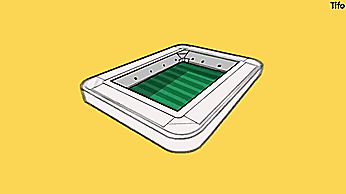
V minulém mistrovství světa, tváří v tvář vysoké teplotě, konfigurace a “plně uzavřený stadion + prodyšný dres” byl obvykle adoptován. Katar zašel ještě dále a vložil do designu stadionu spoustu vynalézavosti.
Za prvé, držte teplý vzduch mimo budovu co nejvíce.
Kvůli omezení přímého slunečního záření je většina z osmi stadionů mistrovství světa v Kataru umístěna na ose východ-západ. Tímto způsobem, když přes den svítí slunce, lze stadionu a tribunám zaručit maximální stín.
Black absorbs heat, so most of the eight pavilions use light-colored surfaces. Even the Gulf Stadium, which was originally designed based on the traditional Bedouin tent in the desert, had to be changed from black to white to cool down. The effect was immediate: the indoor temperature dropped by 5°C in one fell swoop.


In order to avoid the “invasion” of sunlight as much as possible, the Education City Gymnasium, one of the eight venues, is designed as a sparkling diamond. The rhombus-shaped facade has super high sunlight reflectivity, making it dazzling and eye-catching; the site is also built slightly lower than the ground to control the temperature inside the site.
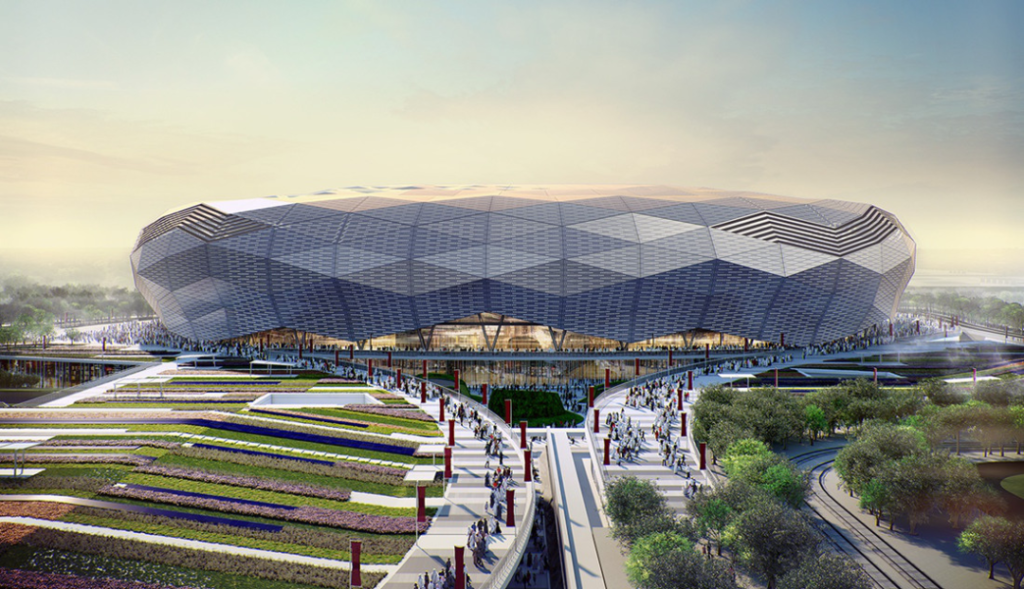
They also used smoke and lasers to conduct a wind tunnel simulation on the 3D printed venue model to observe the flow of air under different wind speeds and air pressures. Let the curvature of the roof disperse the hot air as much as possible, without entering the interior of the venue.

If you can’t move it away, you can also close the roof.
Take the Al Wakrah Stadium designed by the famous architect Zaha Hadid as an example. Its roof is retractable and can be closed within 30 minutes. Like a sail covering the pitch, it cools the spectator area down to 18°C. Even when the roof is open, the folds of the roof guide the air towards the perimeter…
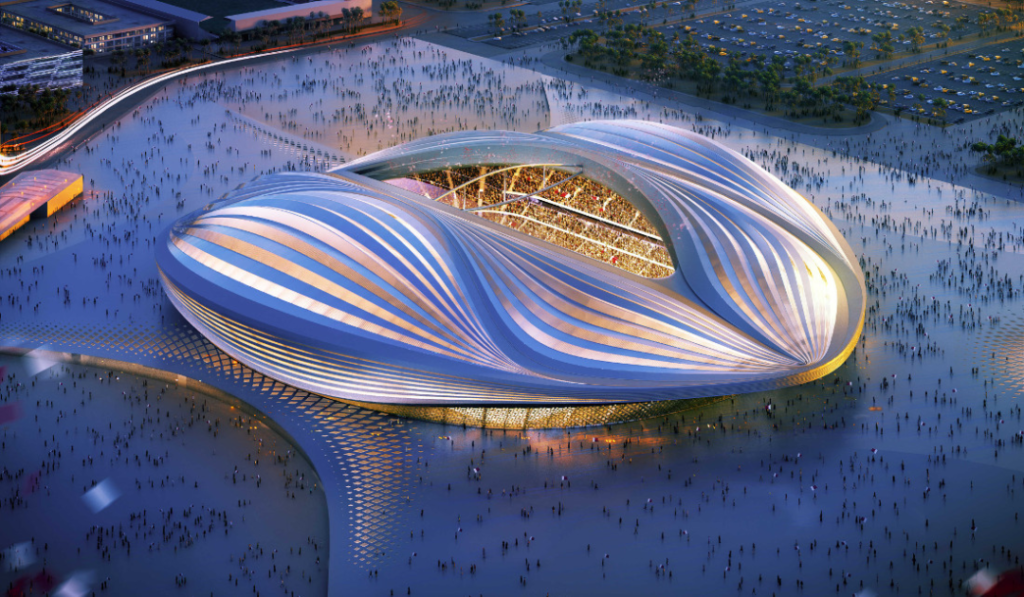
Existuje ještě jeden nápad, který působí trochu surrealisticky. V roce 2011 Qatar University vyvinula solární pohon “mrak” na mistrovství světa. Zvedne se pomocí palubního vaku s heliem a umístí se pomocí dálkového ovládání a může vrhat stín na kurt, když svítí slunce.
Pokud jde o to, zda se v tomto turnaji skutečně používá, počkejme a uvidíme.

Ani venku se nešetřilo. V Dauhá, hlavním městě Kataru, bylo mnoho silnic natřeno jasně modrou barvou, aby absorbovaly méně slunečního záření a odrážely ultrafialové paprsky, čímž se snížila tělesná teplota projíždějících chodců a motoristů.
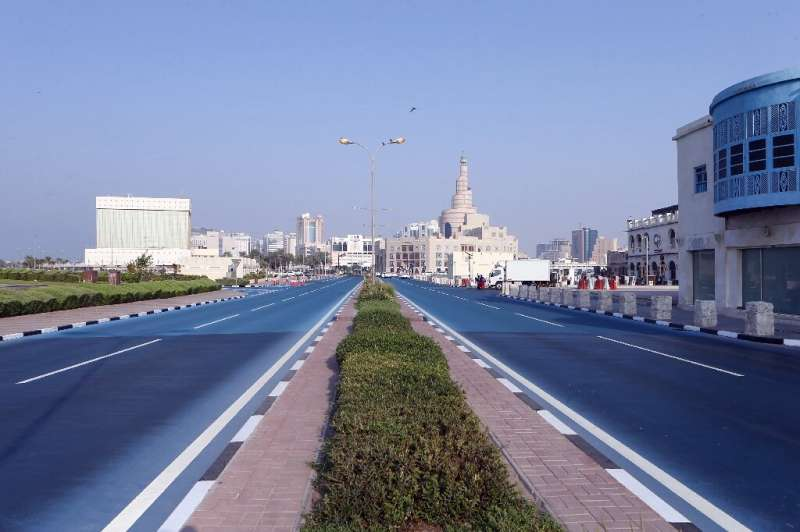
Nejdůležitější je ale spolehnout se na obrovskou klimatizaci
To put it simply, during the World Cup, the venues will continuously deliver cold air to the venue to create a two-meter-high, “completely isolated” cool bubble. When the room temperature is the lowest, it will be 20°C lower than that outside the venue.
2. What kind of system is this?
First of all, under the seats of the auditorium, there are hundreds of vents “hidden”, just like the small nozzles of the shower head. They will blow out low-intensity but dense cold air from the height of the audience’s ankles, allowing the air to circulate gently instead of “whistling” to make people headache.
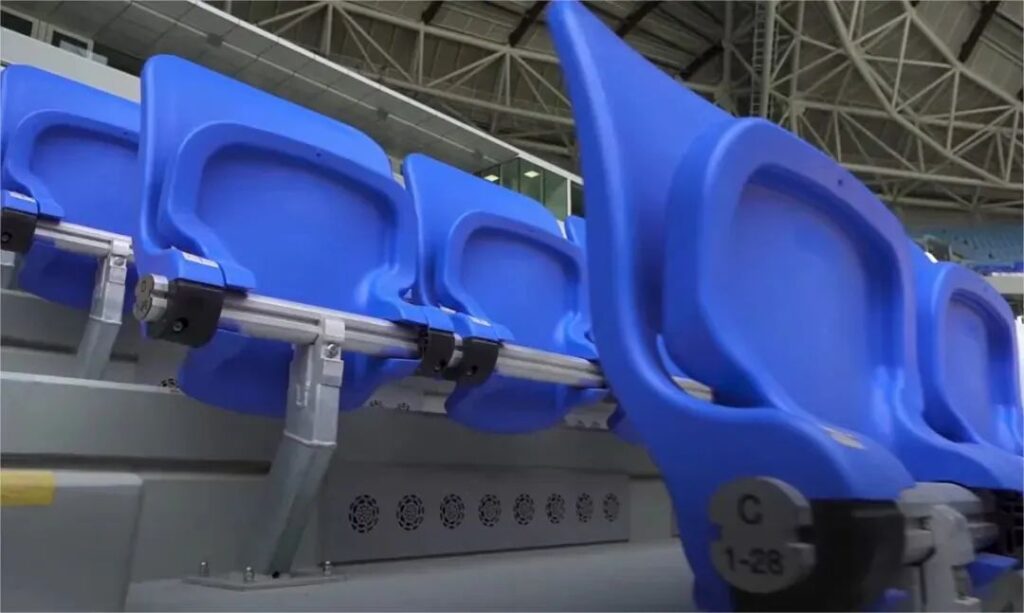
For players, the need to cool down is even more urgent.
According to research, in a single game, each player has to run more than 10 kilometers and consume more than three liters of sweat. In Qatar’s tropical desert climate, failure to dissipate heat well can lead to heat exhaustion.
Therefore, many large nozzles are placed around the court. Each of these air outlets has a diameter of more than tens of centimeters, and the wind is very strong, bringing cold air to the contestants and referees in the field.
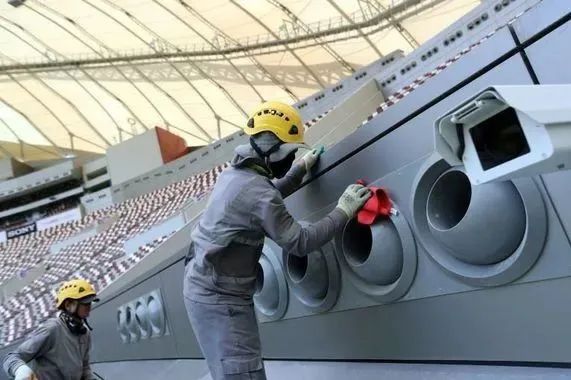
The special feature of this system of “large and small nozzles” is that its purpose is not to cool down the entire venue, but to “directed cooling” more precisely, and only acts on the area where people appear. That’s less than one-tenth the size of the entire space. Engineers have developed a set of precise fluid dynamics models: by measuring the speed and angle of air flow, the angle of each air outlet is set.
An ultra-thin giant air-conditioning barrier no more than 2 meters above the ground came into being.
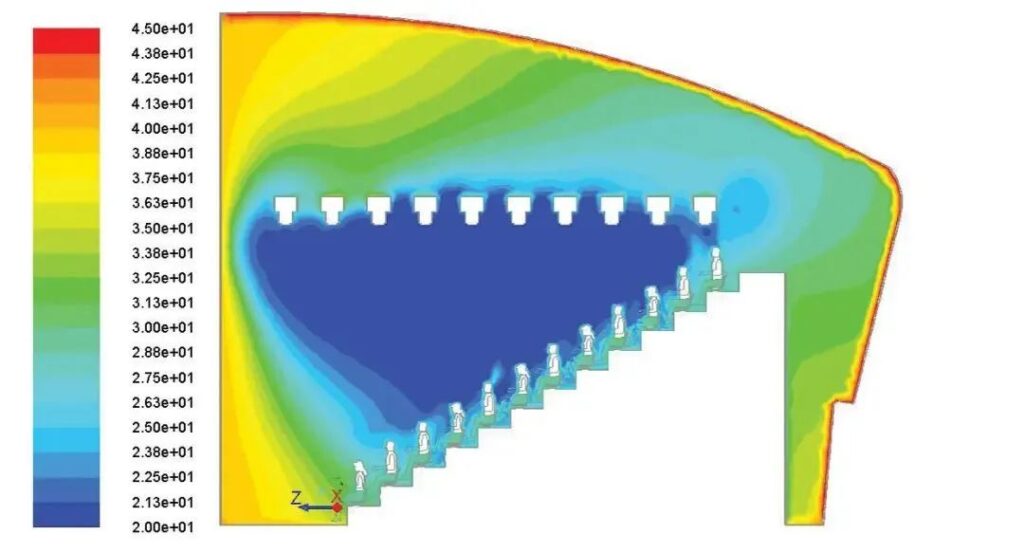
However, if the air conditioner is too strong, there will still be some risks.
For example, before the AFC West Asia ¼ match at the Education City Gymnasium in midsummer this September, the Persepolis team, who was about to play, was worried that the air conditioner would be too cold and they would catch a cold easily, so they thoughtfully prepared blankets for the substitute players…
In addition, many people think that in Qatar, which is full of local tyrants, the cooling system of the World Cup is simply to win by numbers. If one air conditioner is not enough, hundreds of them are installed. As everyone knows, it is actually a set of energy-saving circulatory system.
Unlike the household air conditioners we are familiar with, this system does not use traditional refrigerants such as Freon, but absorbs energy from solar panels, and then uses an expensive absorption chiller to cool an independent water circuit. The 7°C cooling water is stored to cool down the air in the venue.
When the cool air becomes hot again, it will be taken away by the exhaust fan located in the middle area, re-filtered, cooled, and then sent into the venue, and the cycle repeats. Minimize the impact of hot air from outside on the inside.
This also acts as an air cleaner. The refreshing air is blown out from the audience’s feet, and then sucked back from the head, just like a small cabin seat, which can filter dust, sweat odor, or new crown virus to a certain extent.

Under this system, the energy consumption of the court is only equivalent to one-fifth of that of an airport terminal with the same area.
The main source of electricity is a large solar power plant on the outskirts of Doha. It covers an area of more than 10 square kilometers and consists of about 1.8 million solar panels. It will power the stadium during the World Cup and about 10% of the country’s power supply after the game.
3. How much does it cost?
Let’s take a look at it as a whole: According to Al Jazeera’s report, the organizers have invested 200 billion U.S. dollars to build the World Cup project. It is expected that the number will not be less than 300 billion U.S. dollars after the event is over.
What is this concept?
The 2014 World Cup in Brazil cost $11 billion. And this World Cup cost more than the previous seven combined.
Regarding the cost of the refrigeration system, a Reuters reporter once interviewed Dr. Saud Abdul Ghani, the technical director and professor of mechanical engineering at Qatar University. The other party did not reply directly to the specific figure, but said: “This is a lot of money.”
However, the reporters still learned about the approximate amount from other sources. Qatar World Cup Organizing Committee officials have stated that the country will spend 650 to 700 million US dollars on all stadiums and training facilities; the project manager of the venue said that because of the addition of a cooling system (a total of 3,000 vents were installed in the venue), The construction cost of the entire venue has increased by 2-3 times, and each seat is “worth” $6000-7000 on average.
Among the tickets sold for the World Cup, the most expensive first-class final ticket is currently priced at 45,800 yuan, which is equivalent to about 6,000 US dollars. The ordinary ticket price for the group stage is around 2,200 yuan, which is only 310 US dollars after conversion.
Can this pay off?
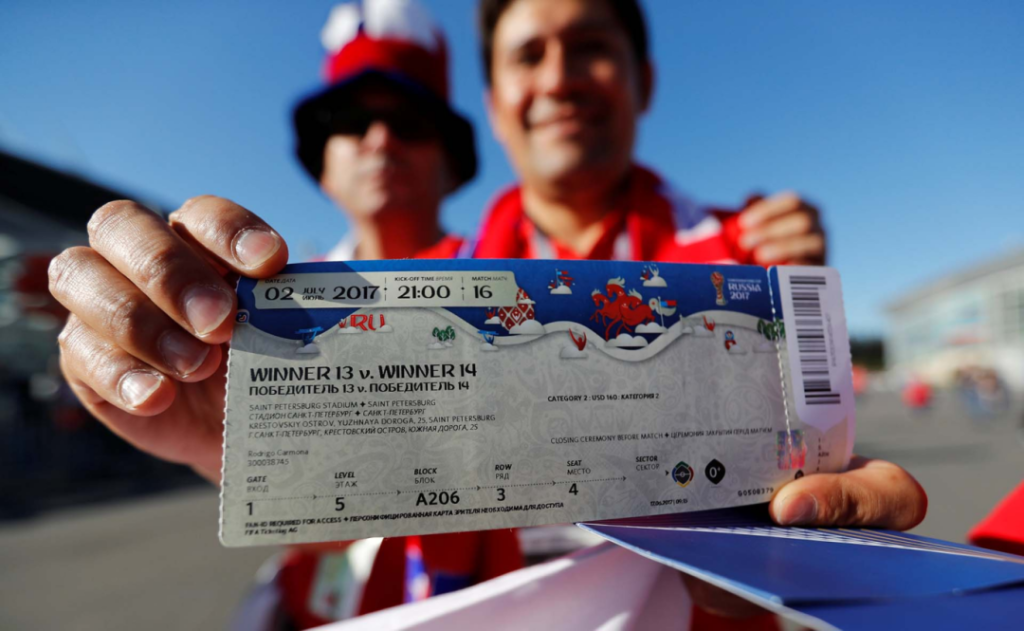
The organizers don’t seem to have too many worries about breaking even.
In previous interviews, they all said that the money they spent was for the long-term economic development of the city and the concept of environmental protection. They put forward a bold idea: the entire competition must achieve carbon neutrality!
FIFA has made a set of comparisons before: because Qatar has a relatively small land area (only about two-thirds of Beijing), thanks to the short distance between venues, less fuel consumption in traffic, and solar cooling technology, it is expected that the World Cup will Carbon emissions are less than a third of those of the last World Cup in Russia.
But when you factor in the carbon emissions from building the stadium (which accounts for 90 per cent of the total) and, because Qatar is too small to accommodate the 1.3 million fans who pour in, many will live in neighboring countries, Those flights are estimated to generate 800,000 tons of greenhouse gases from the daily round-trip flights to watch the game. It’s not a small number when added up—it’s equivalent to driving a passenger car around the world 80,000 times.
Compared with household air conditioners, according to the data released by a domestic brand this year, the carbon footprint of an air conditioner in its entire life cycle is 4119.38 kg CO2eq—equivalent to 194,000 air conditioners operating at the same time.
The organizers have previously stated that they will actively plant trees and manage waste as compensation. To that end, they planted 16,000 trees and nearly 700,000 nursery shrubs, commissioned 800 new electric buses, and a new 800-megawatt solar power plant.
But in the end, it’s all about money.
The carbon neutrality of this World Cup will be achieved mainly through the purchase of carbon credits. So far, Qatar has committed to purchase 1.8 million carbon offsets from the Global Carbon Council. But as of November 14, the Global Carbon Council had awarded it only 550,000 credits, which is just 15 percent of what is needed to achieve carbon neutrality for this World Cup. This, combined with the immaturity of the carbon offsetting system itself, has many questioning Qatar’s commitment to carbon neutrality.
Cooling the planet seems to be a bigger problem than cooling the stadium.










